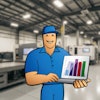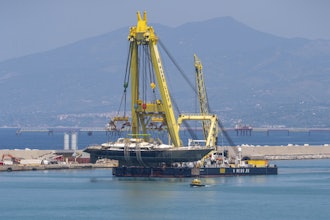Harvard Business Review recently published research which confirmed that industrial manufacturers are one of the top four adopters of Augmented Reality. From asset design to instruction manuals, asset-intensive industries are implementing augmented reality experiences to provide product-immersive experiences for employees and customers.
Comparesoft researched three main areas to understand why industrial houses are investing and adopting augmented reality applications. Before we get into the reasons, it might be useful to agree on what virtual reality is, becuase quite often the terms simulated environment, virtual reality and mixed reality can be confusing. When you overlay virtual information on a real environment, it is known as augmented reality. For simulated or virtual reality, you overlay virtual information on a virtual environment.
No. 1 - Augmented Reality for Asset Design
Traditionally, asset design or conceptual design involved assuming conditions that were as close as possible to real (asset) operating conditions. For example, you would use 2D or 3D models and simulate real operating conditions around it.
With augmented reality, you have the ability to design in real conditions without actually having to be present in the real condition. This is more powerful than it sounds: a lot of critical design is actually for the internal design of complex equipment. For example, designing camshaft, gears, centrifugal pumps etc in real conditions eliminates design anomalies for asset designers. The immersive experience offered by augmented reality helps product designers to get a real sense of their design in real operating environments, enabling them to create better products.
Alstom Transport, for example, uses augmented reality to design trains. Using AR they create real conditions based on how trains operate, enabling their design teams to provide better travel experiences.
Another great example is BAE Systems, who use augmented reality to design their warships.
No. 2 - Augmented Reality Closes the Gap Between Asset Inspection and Asset Maintenance
One of the key challenges with asset inspection has been that a user of an asset is not necessarily an expert on the asset. For example, a farmer may not know what has gone wrong with his tractor or a production manager may not know the exact reasons equipment is malfunctioning. Traditionally, the way to get around this challenge was that experts would physically need to inspect the asset to check its condition. Depending on the inspection, the expert would then need to take corrective action which often involved ordering new components and creating a maintenance schedule. This typically required two or three physical trips to the asset location. With augmented reality, the requirement for a physical inspection can be reduced or even eliminated. Using augmented applications, asset conditions can be fully understood so the expert can take corrective maintenance actions. Quite often this can be achieved virtually, too. In either case, by using augmented reality, the experts do not need to take multiple trips to inspect, repair and maintain assets.
This concept is already implemented by Caterpillar. They have developed an application which helps their customers to explain and resolve equipment issues via their augmented immersive experience.
Another well-known example is ThyssenKrupp Elevators. They use virtual reality to inspect elevators and repair them. One of the key advantages with their setup is that the technician is hands-free to carry out the repair and at the same time can uncover information about the elevator being repaired. Traditionally, this required accessing a laptop which meant the technician could either look at the information or carry out the repair. Their AR setup allows their technicians to do both. They suggest that a job which typically used to take one-to-two hours can now be carried out in less than twenty minutes.
No. 3 - Augmented Reality for Technical Talent Development
For asset-intensive and complex industries, the capability to overlay virtual information on a real environment enables complex industries to train their employees on every aspect of asset lifecycle management. This component is a strong driver behind the adoption of AR by asset-intensive industries.
A recent (May 2017) research by Cranfield University revealed that engineers and technicians made it to the top two on the skills shortages in UK manufacturing:
In the U.S., the overall gap between availability and shortage of skills is best depicted by the graph below:
Since augmented reality reduces the need for physical interface between humans and industrial-operating environments, it enables companies to provide their technical talent with a platform to test and iterate in real operating conditions. This allows them to train at a faster rate and bridge the technical experience gap.
AR Adoption Challenges:
There are two main adoption challenges that AR applications are facing today:
- Miniaturization Issue: People prefer augmented reality headsets to be of the same size as normal eyeglasses. This is an adoption challenge as the functionality offered by AR headsets requires them to be bigger than normal eyeglasses. BAE Systems are one of the industrial companies who have launched their glasses to address this issue.
- Digital Fatigue: Human beings are not used to augmented reality – the combination of spatial computing as well as real-world information blended with virtual information can cause digital fatigue.
Whilst there are always adoption challenges with any new technology, augmented reality is already influencing the asset lifecycle management of asset-intensive industries so much that they are one of the top four adopters of augmented technology.
Prasanna Kulkarni is founder and product architect of Comparesoft.






















